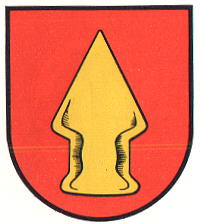Niederbühl: Difference between revisions
Jump to navigation
Jump to search
Knorrepoes (talk | contribs) m (Text replace - "|width="15%"|50 px|right |}" to "|width="15%"|50 px|right |}<seo title="Wappen, Gemeindewappen" />") |
Knorrepoes (talk | contribs) m (Text replace - "[[Literature" to "{{media}} [[Literature") |
||
| Line 20: | Line 20: | ||
The arms are already seen on the oldest known seal of Niederbühl, known from 1583. The plough iron is most likely the old village symbol. All later seals and images show the plough iron, but the shape is often changing and sometimes even difficult to identify as such. The colours were determined when the arms were officially adopted in April 1901. | The arms are already seen on the oldest known seal of Niederbühl, known from 1583. The plough iron is most likely the old village symbol. All later seals and images show the plough iron, but the shape is often changing and sometimes even difficult to identify as such. The colours were determined when the arms were officially adopted in April 1901. | ||
{{media}} | |||
[[Literature]] : Zier and Futterer, 1966. | [[Literature]] : Zier and Futterer, 1966. | ||
Revision as of 02:18, 9 July 2014
| Heraldry of the World Civic heraldry of Germany - Deutsche Wappen (Gemeindewappen/Kreiswappen) |
NIEDERBÜHL
State : Baden-Württemberg
District (Kreis) : Rastatt
Incorporated into : 1972 Rastatt
Official blazon
In Rot eine gestürzte goldene Pflugschar.
Origin/meaning
The arms are already seen on the oldest known seal of Niederbühl, known from 1583. The plough iron is most likely the old village symbol. All later seals and images show the plough iron, but the shape is often changing and sometimes even difficult to identify as such. The colours were determined when the arms were officially adopted in April 1901.
Contact and Support
Partners:
Your logo here ?
Contact us
© since 1995, Heraldry of the World, Ralf Hartemink 
Index of the site
Literature : Zier and Futterer, 1966.











